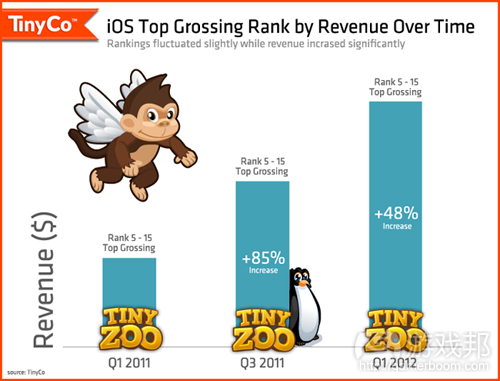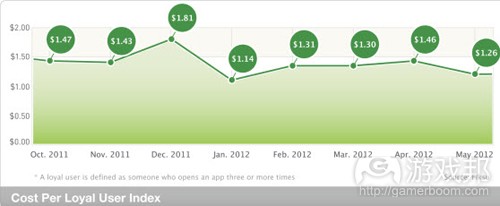每日观察:关注营收榜单前列iOS应用收益增长率(6.30)
1)手机游戏开发商TinyCo最近发表博文指出,在2011年第一季度至第三季度,一款iOS应用若想保持营收榜单第5至第15名位置,其在此期间的收益就必须实现85%的增长率;而在2012年第一季度应用若想维持同样排名,其收益就必须比2011年第三季度增长48%。
尽管TinyCo并未透露具体收益数据,但我们可以根据其他初充信息进行推测。去年夏季有消息称iOS营收榜单前列的应用每月收益为200万至300万美元,如果按照85%的增长率来看,到第三季度其收益就必须是每月350万美元,今年第一季度其每月收益就应该超过500万美元。
去年12月份,Epic曾宣布《无尽之剑2》发布首月收益达500万美元,今年5月份GREE则透露其收购的Funzio公司每月收益超过500万美元,而后者游戏在iOS营收榜单最高排名是第20名。
2)Fiksu最近数据显示,今年5月份iOS应用下载量为454万次,比四月份的423万次增长7.3%,但仍远低于1月份时的679万次;去年同期下载量为378万次。
5月份每名iOS忠实用户获取成本为1.26美元,比4月份的1.46美元下降13.7%,但远超过去年同期的1.1美元。Fiksu认为苹果在5月份开始限制使用UDID的举措,可能就是广告商和营销人员减少应用营销投入的一大原因。
3)据日经新闻报道,Android游戏《Rage of Bahamut》目前每日收益达4.3万美元,值得注意的是这一数据并不包括其在日本市场收益。东京游戏顾问Serkan Toto还曾推测称该游戏在iOS和Android平台的全球每月收益可能高达260万美元。
据Techcrunch报道,ngmoco首席执行官Neil Young曾在之前采访中透露,一款成功的游戏每名活跃用户日均收益约15-25美分,而《Rage of Bahamut》活跃用户日均收益则是这一数据的4-5倍。
据此推算,该游戏每名DAU日均收益应为1美元左右,这一结果似乎有违Android游戏盈利性低于iOS游戏这种常理。
4)据BGR报道,亚马逊现在正研发两款新Kindle Fire平板电脑,其中一者是7英寸版本,另一种是10英寸版本(名称为Hollywood,采用四核芯片)。
观察者称亚马逊10英寸平板电脑将与9.7英寸的iPad展开正面交锋,而其7英寸平板电脑则将与谷歌最近宣布的Nexus平板电脑角逐低端市场。
这两款平板电脑的设计可能比原版Kindle Fire更薄,采用micro USB插槽,而Hollywood版本则可能植入前端摄像头。
亚马逊原版Kindle Fire今年第一季度销量仅70万部,远逊于去年第四季度时的400万部。
5)据Digital Spy报道,Epic Games高级美术设计师Alan Willer日前透露,公司新版开发工具虚幻引擎4不会支持当前的智能手机和平板电脑设备。
他表示如果开发者追求的是更多渲染功能和更快的速度,虚幻引擎3已经能够有效支持当代移动设备,只是它能使用的工具不如虚幻引擎4那么多;如果虚幻引擎4也支持移动设备,那就会出现两种工具重叠的情况。
6)据pocketgamer报道,Adobe日前宣布从8月15日起Flash Player不再支持Android平台,将从Google Play移除Flash Player。
这也意味着Adobe的Flash插件将不再支持新一代Android操作系统Jelly Vean,所有以Flash编写的页面、条幅广告及游戏将不可在搭载Jelly Bean的移动设备上正常运行。
据Adobe所称由于每个Android操作系统版本安装Flash Player时都要进行认证,这意味着Flash无法保证在每个Android移动设备上顺利运行的一致性。因此Adobe决定放弃对Android设备的支持,不过现在已安装Flash的Android用户仍可继续更新其安全补丁。但如果用户将设备升级至Jelly Bean操作系统而没有卸载Flash,那就可能“发生意想不到的情况”。(本文为游戏邦/gamerboom.com编译,拒绝任何不保留版权的转载,如需转载请联系:游戏邦)
1)Want to be a top grossing iOS app — you need to earn about $5M a month now
Kathleen De Vere
Having an app on the top grossing iOS app charts is more lucrative than ever — according to new figures revealed by TinyCo, an app that has maintained a rank between No. 5 and No. 15 on the top grossing iOS app chart has more than doubled its earnings year-over-year.
According to the San Francisco-based mobile developer in a recent blog post, an app’s revenue had to increase by 85 percent between Q1 and Q3 2011 in order to maintain a chart position between No. 5 and No. 15 on the top grossing app charts. By Q1 2012, that app would have to earn a further 48 percent more than it was earning in Q3 2011 just to stay in the same position.
Although TinyCo doesn’t reveal exact earnings figures, we can estimate how much a top grossing app is earning today based on their information. Last summer, we had heard from several sources that a top grossing app was earning about $2 to $3 million a month on iOS. This means by Q3 the same app was earning about $3.5 million a month in order to keep up with the 85 percent increase reported by TinyCo. By the first quarter of this year, a top grossing app’s earnings were likely over $5 million a month as the rate of revenue growth on iOS increased by a further 43 percent.
While these numbers are more than double what we’ve heard before, they’re well within the realm of possibility. In December, Epic’s Infinity Blade II earned $5 million in its first month of release. In May, GREE revealed the newly acquired Funzio was earning more than $5 million a month from its suite of social and mobile games, and the highest average chart position those games held on the top grossing iOS app charts was No. 20.
Considering the amount of new iPhones and iPads activated during the year and the increased competition in the iOS app store, it’s not unreasonable to conclude apps are earning more now.
TinyCo also credits the shift towards the free-to-play monetization model with the rise in app revenues, restating the widely-accepted fact that free apps drive higher average revenue per paying user and produce users with a higher lifetime value.(source:insidemobileapps)
2)Relief for developers? Apple app downloads pick up in May while marketing costs dip
Dean Takahashi
For much of this year, the number of downloads in the Apple App Store has dropped, and the cost of acquiring new users — the basic marketing that developers do in order to get people to buy apps or virtual goods — has been going up. But developers got a little relief in the month of May, according to indices tracked by mobile ad firm Fiksu.
The number of downloads was 4.54 million in May, up 7.3 percent from 4.23 million in April but still down significantly from the peak this year of 6.79 million downloads in January. The number of downloads a year ago was 3.78 million, so the download number still shows good year-over-year growth.
The cost of acquiring a loyal user (one who opens an app three times) decreased 13.7 percent in May to $1.26 per user, compared to $1.46 per user in April. But the marketing costs are still significantly above the $1.10 per user a year ago, according to Boston-based Fiksu.
When you figure that a lot of apps are free or cost only 99 cents, those are steep marketing costs. That means developers have to take a risk of spending money up front on marketing and advertising to get users. Then they have to hope that those users will spend money on virtual goods within the app over time, helping the developer to recoup those costs.
“In May, marketers began gearing up for the summer months which, historically, have presented increased opportunity for app promotion,” said Micah Adler, CEO, Fiksu.
During the month, Apple started getting rid of apps that used the Unique Device Identifier (UDID), a number that helped advertisers and developers track users for better targeted marketing. That may have caused advertisers and marketers to back off on spending during the month.
“Yet amid concern around Apple’s speculated deprecation of UDID, compounded by a host of confusing alternative UDID-less tracking technologies, we observed inertia,” Adler said. “It appears that brands’ caution may have contributed to the dip in acquisition costs.”
In other words, there may have been a lull in the problem of constantly rising acquisition costs. Developers have been so concerned about that issue that we’re going to talk about it at our upcoming GamesBeat 2012 conference (see below). The panel will be moderated by Steve Peterson of GamesIndustry International. Panelists include Gabe Leydon, CEO of Machine Zone; A.J.
Yeakel, mobile strategy consultant; and Rob Weber, co-founder of W3i.
Large advertising campaigns by Japanese mobile social game network companies DeNA and Gree have contributed to rates going up, said Weber at W3i. He also noted that the end of the UDID usage — without a good replacement — also may have reduced the effectiveness of ad campaigns during the period, causing inefficient marketing spending. Some efforts are under way to help deal with the inefficiency.
For the future, another force that may drive down user acquisition costs is the deep integration of Facebook into iOS with the new version of Apple’s mobile operating system. Facebook allows users to share games and apps with each other in a viral way. That means developers don’t have to spend as much on app marketing. At some point, that could offer relief for user acquisition.
Fiksu tracks more than 1 billion app events per day such as launches, registrations, and in-app purchases.(source:venturebeat)
3)DeNA’s Rage of Bahamut estimated to be grossing $2.6 million a month
by James Nouch
According to figures from Nikkei, the Android version of DeNA’s Rage of Bahamut is grossing as much as $43,000 per day.
That’s a figure excludiing revenues earned in Japan.
And, performing some additional back-of-the-envelope calculations, Tokyo-based gaming consultant Serkan Toto believes the game’s worldwide monthly revenue across iOS and Android could be as much as $2.6 million.
DeNA recently dubbed its freemium card-battler “America’s number one mobile app,” when the title briefly occupied the top spot on both the iOS and Android top grossing charts.
Trend-bucker
In an interview with TechCrunch, ngmoco’s Neil Young has previously pegged the typical revenue per daily actve user for a successful game at around 15-25c per day.
Rage of Bahamut, he boasted, is doing “4-5 times” that number.
On this basis, Toto speculates that Rage of Bahamut is probably earning around $1 each day for every DAU. And interestingly, the game seems to be bucking a trend wherein Android games see weaker monetisation rates compared to their iOS counterparts.(source:pocketgamer)
4)Amazon to ignite a tablet war with ten-inch Kindle Fire?
by Zen Terrelonge
Move would bring web giant into direct competition with iPad.
Amazon is working on two new Kindle Fire tablets, says BGR. They are a seven-inch model (same size as the original) and a ten-inch version called the ‘Hollywood’, powered by a quad-core chip.
The latter would take the fight for supremacy directly to the 9.7-inch iPad, while a souped up seven-inch design would look to take swing at Google’s newly announced Nexus 7.
Both of these are expected to feature an ‘improved build’ and a metal casing, offering a chrome-look to replace the plastic backing that can be found on the existing Fire.
Meanwhile, the next-generation designs are set to be thinner than the first, including a micro USB slot, while the Hollywood is expected to feature a front-facing camera.
And it seems feasible that the launch (if true) could be international this time, rather than a North America only release, following Amazon’s recent announcement to bring its AppStore to Europe.
It would be the next logical step, given that the Kindle Fire only generated sales of 700,000 in Q1, an almighty fall from grace on Q4 when it arrived to fanfare with sales of four million to become the world’s number two tablet behind the iPad.(source:mobile-ent)
5)Unreal Engine 4 won’t be coming to current-gen smartphones and tablets
by Anthony Usher
Alan Willer, Epic Games’s senior technical artist, has stated that the next iteration of his company’s Unreal Engine, Unreal Engine 4, won’t be appearing on current-gen smartphones and tablets.
“I’m sure at some point mobile will be a major consideration, but not the current generation of iOS devices right now,” Willer told Digital Spy in a recent interview.
“We’re definitely going to be very aggressive about what platforms we put it on, but there’s definitely going to be a minimum spec in which, okay, this is our entry level for Unreal Engine 4.”
“Unreal Engine 3 is obviously working very well for us on [the] current generation of mobile devices and probably going forward for quite a while,” Willer added.
Overlap
Miller said that when the forthcoming engine does eventually make it to mobile devices, there’s bound to be a “period of overlap”.
“If all we’re looking at is support for more rendering features and speed, then UE3 will continue to work on those [devices], you just won’t have all the tools that UE4 has. Or you can do UE4, and have a set of limits on what you can do, and have access to those tools. I don’t know if there’s going to be a hard fast, ‘You must change over here’,” he commented.
“For a while it obviously makes sense to just ship using UE3, then we’ll sort out what our mobile plans are that will become part of the UE4 suite of abilities.”(source:pocketgamer)
6)Adobe drops all Android Flash support, removing Flash Player from Google Play
by Mike Rose
The future is looking bleak for Flash Player on Android devices. From August 15th, Flash Player will no longer be available to download from the Google Play Store.
That’s not all, though: it’s been confirmed that Adobe’s Flash plug-in won’t be supported in the upcoming Android OS update, Jelly Bean, meaning pages, banners, and games written in Flash may not load properly when viewed on a device running Jelly Bean.
Abode said that the required certification of each Flash Player implementation by each separate partner program for Android means that Flash doesn’t always work on every device, and, thus, fragmentation ensues.
As a result, Adobe is looking to drop Flash support for Android devices altogether. However, if you own a device that currently has Flash installed on it, you will continue to receive security patches for it.
The maker of Photoshop and Dreamweaver warns that if you upgrade your device to Jelly Bean but don’t uninstall Flash, it may “exhibit unpredictable behavior”, as 4.1 Flash simply isn’t supported.
Is this such a big deal, then? Well, Apple’s mobile devices have never supported Flash content, and they’ve got by just fine, with The Big A preferring to focus on supporting web standards such as HTML5 on its iPhone and iPad platforms, instead.(source:pocketgamer)














































 闽公网安备35020302001549号
闽公网安备35020302001549号